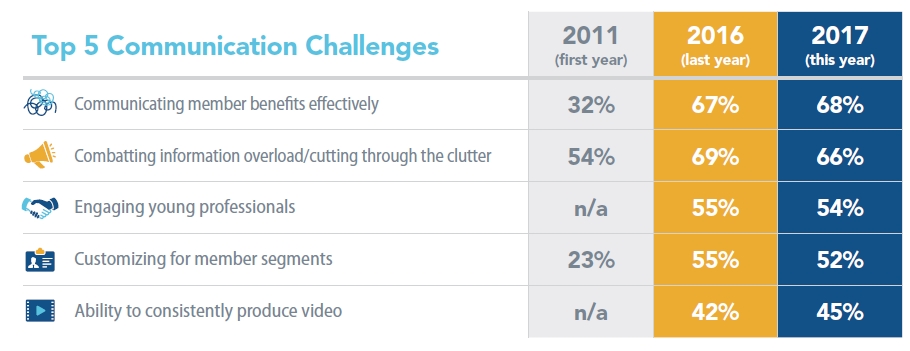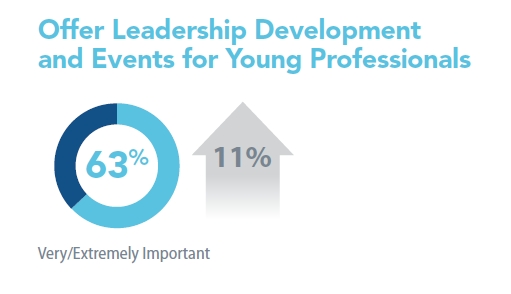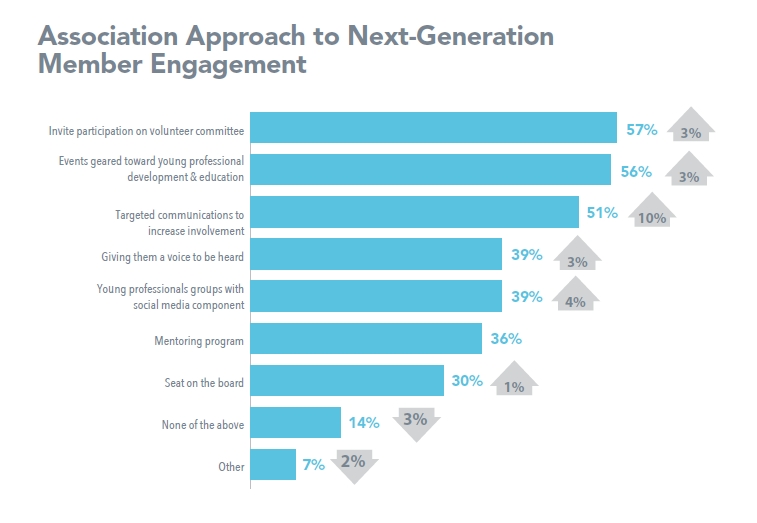The Young Professional – Tracking down the Future Leaders of Your Association
Part 4 of our 2017 Association Communications Benchmarking Study series
Acknowledging a challenge is the first step to finding a solution. This year, more than 50 percent of associations said that engaging young professionals is one of their Top 5 communication challenges. So good job, you are on your way!

Sixty-three percent of associations feel offering leadership development and events for the next generation of professionals is extremely important. We wholeheartedly agree. Growing a robust population of young professionals is essential to the future of your organization. If you’re not a millennial – loosely defined as people born between 1980 and 2000 (ages 18 to 38 years old today) – you may feel that you are unqualified to understand what motivates them. Or you may feel you have tried everything already and achieved inconsistent or unsatisfactory results. It may help to consider that the newest generation of professionals is accustomed to interacting with many more information sources than ever before. With so many distractions, young professionals today could benefit from focused communication.

The good news is most of you are already putting in the work.
- 51 percent of associations surveyed create communications targeted to younger members
- 57 percent invite younger members to be on volunteer committees
- 56 percent gear events toward education and development for young professionals
- 36 percent offer mentoring programs
- 7 percent of associations provide highly customized communications for early career (<2 years) members.
- 28 percent somewhat customize communications for this group.

Build on your success with these tips:
Focus Your Communications
Segment your content.
In Part 3 of our 2017 Association Communications Benchmarking Study series, we told you that different groups of members have different information needs. Young professionals represent a group qualified for tailored content. Provide audience-specific columns, emails or eNewsletter features to grab their attention. “Roundups” also work great for this audience. This is a piece of content that delivers all the best information sources for a topic in a single article or email, so the audience doesn’t have to find it themselves.

Build an editorial-focused website.
Did you know that readers engage with content at much higher rates when it is on an editorial website? Newsworks (UK) recently published a study that confirms the level of engagement due to personal relevance is 50 percent higher on editorial sites. Creating a website specifically for the content young professionals desire will make the materials easy to find, build a trusted community around your association’s youngest members and elicit more active involvement from a population that is looking for guidance.
 We spoke with Charlotte Perham, vice president of communications & marketing for the Plumbing-Heating-Cooling Contractors – National Association (PHCC), who told us about their new website, www.phccareers.com, that showcases a modern, exciting and technologically skilled trade. “Geared for 16- to 24-year-olds, the responsively-designed site offers a host of training resources, including apprenticeship programs; direct links to PHCC chapters where visitors can learn more about training programs and careers in their local areas; scholarship information; and other materials showcasing the options and opportunities within the industry,” she said.
We spoke with Charlotte Perham, vice president of communications & marketing for the Plumbing-Heating-Cooling Contractors – National Association (PHCC), who told us about their new website, www.phccareers.com, that showcases a modern, exciting and technologically skilled trade. “Geared for 16- to 24-year-olds, the responsively-designed site offers a host of training resources, including apprenticeship programs; direct links to PHCC chapters where visitors can learn more about training programs and careers in their local areas; scholarship information; and other materials showcasing the options and opportunities within the industry,” she said.
PHCC state chapter organizations have also developed websites and tools to attract the younger generation with many positive results. “For example,” Perham explained, “PHCC of Indiana has reached more than 4,600 students at its career fairs. And, that chapter’s customized workforce website generated 5,000 clicks in a five-month period – 230 of which were to submit an interest form.”
Furthermore, engagement with PHCC’s national website is resulting in action offline as well. “Thanks to regular promotions, including a social media advertising campaign, a new 30-second #FindYourCareerFix video has received more than 50,000 views to date, and enrollment in the PHCC Educational Foundation Apprentice eLearning program has increased by 200 percent,” Perham said. Those are big numbers!
Promote Your Communication Vehicles
You have done the work to create valuable resources for your members. Now consider this permission to show off.
Cross-promote your publications.
Think about ways you can introduce readers of your eNewsletter to your magazine or readers of your magazine to your website. Do you have copies of your magazine available at events for young professionals?
Make resources easy to find.
Ensure members can get to the good stuff fast by placing a Resources or Publications tab on the navigation bar of your website. If links to your digital resources are not a few clicks away, most people will naturally lose interest in their search.
Don’t lock resources to members only.
While locking resources to members may seem like a good way to build membership value, doing so limits the audience for the people who worked hard to create those resources, and prevents potential members from seeing the full picture of what your association does for individuals and the industry. A lot of work goes into the articles that fill your magazines, enewsletters, websites and more. Reward those who create content by letting anyone and everyone share your content far and wide. Sharing pieces of content with word-of-mouth-based social networks like Twitter and LinkedIn will generate interest in your organization.
Still want to reserve something for members only? You can continue to offer free print subscriptions for members while making digital versions available to everyone.
Measure. Revise. Measure More.
Practice makes perfect, and member engagement is no exception. Twenty-six percent of associations report they have no process for measuring engagement with their communications. Communications measurement should be an area that you make a priority today.
Test before you send.
A/B testing is a valuable way to ensure your communications are living up to their potential. For example, if you decide to launch an email campaign targeted at young professionals, try creating two versions with slightly different content or subject lines. Worldata.com suggests you send Email A to 5 percent of your email list and Email B to a different 5 percent of your email list. Review the open rates for both emails and send the more successful email to the remaining 90 percent of your email list.
Dive deeper.
On the 2017 Association Communications Benchmarking Study, 65 percent of associations reported that they measure the attendance of young professionals at events. Think of ways to go beyond just a head count. For example, a pre-event survey asking young professionals which sessions or networking opportunities they plan to attend can tell your association which topics are popular among members. A post-event survey asking which sessions they actually found valuable could tell you which speakers this audience found the most engaging and which content deserves further space in your magazine, newsletter, webinar schedule or future event lineup.
Revisions are your friend.
Throw your ideas about failure out of the window. There is no such thing as a failed strategy, only leaders who fail to shift their strategy when supplied with evidence it could be even better.
 The Ceilings and Interior Systems Construction Association (CISCA) recently revamped its Emerging Leaders Program. Shirley Wodynski, executive director of CISCA, says the organization sensed that participants in the program were looking for different things than those who were in the program previously. CISCA then “spent a lot of time talking to younger members, those who went through the program previously, employers and other members to ascertain what they wanted and what was needed in an Emerging Leaders program,” she said. “At the end of all of the research, we decided the best option was to have a program where emerging leaders got together, face-to-face, a couple of times a year. There are also two webinars between the in-person meetings.”
The Ceilings and Interior Systems Construction Association (CISCA) recently revamped its Emerging Leaders Program. Shirley Wodynski, executive director of CISCA, says the organization sensed that participants in the program were looking for different things than those who were in the program previously. CISCA then “spent a lot of time talking to younger members, those who went through the program previously, employers and other members to ascertain what they wanted and what was needed in an Emerging Leaders program,” she said. “At the end of all of the research, we decided the best option was to have a program where emerging leaders got together, face-to-face, a couple of times a year. There are also two webinars between the in-person meetings.”
Now it’s your turn.
Tell us how you are engaging young professionals and then measuring your success with this important demographic.
 Elyce Gronseth is a marketing account specialist with Naylor Association Solutions.
Elyce Gronseth is a marketing account specialist with Naylor Association Solutions.

